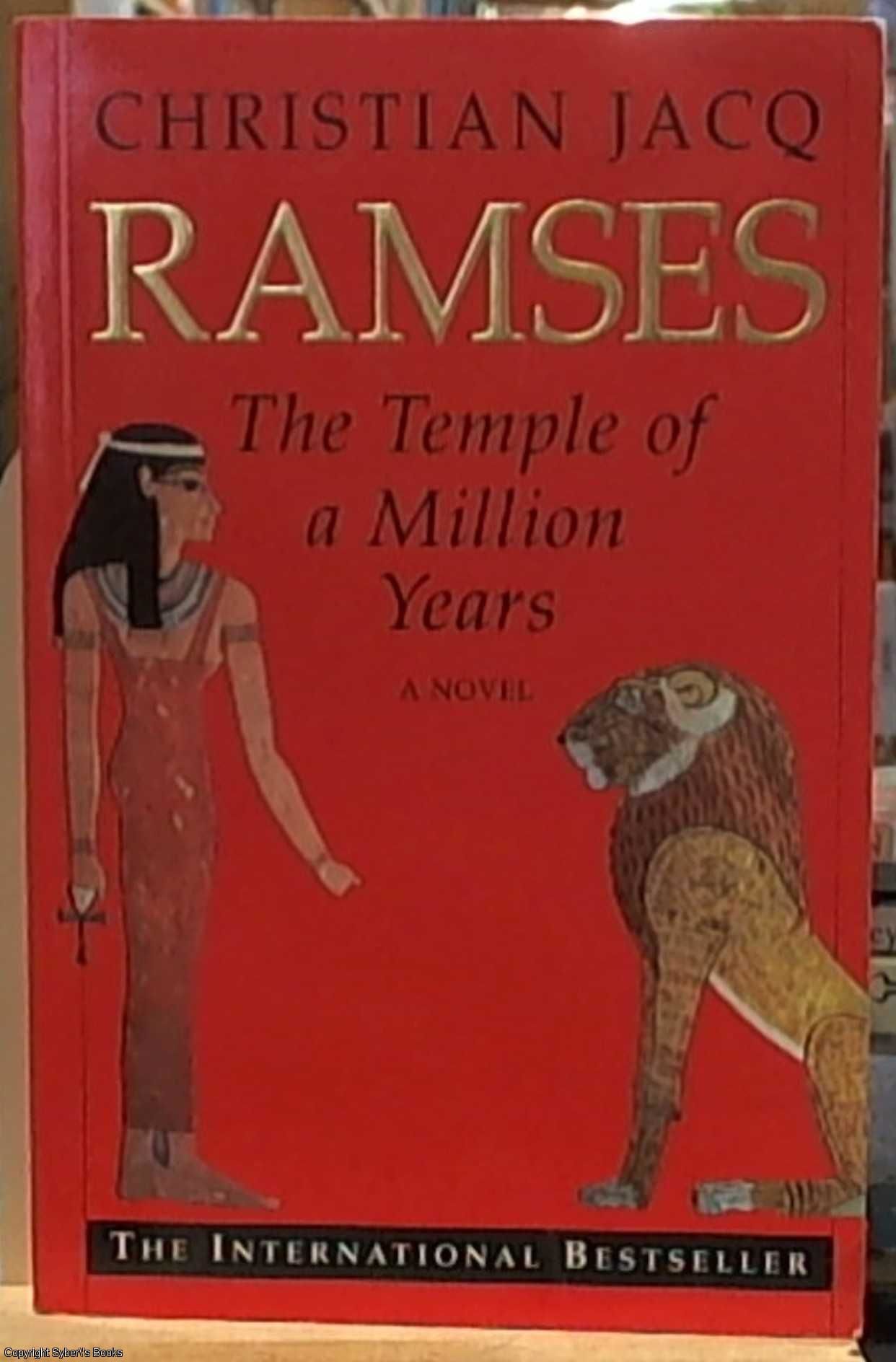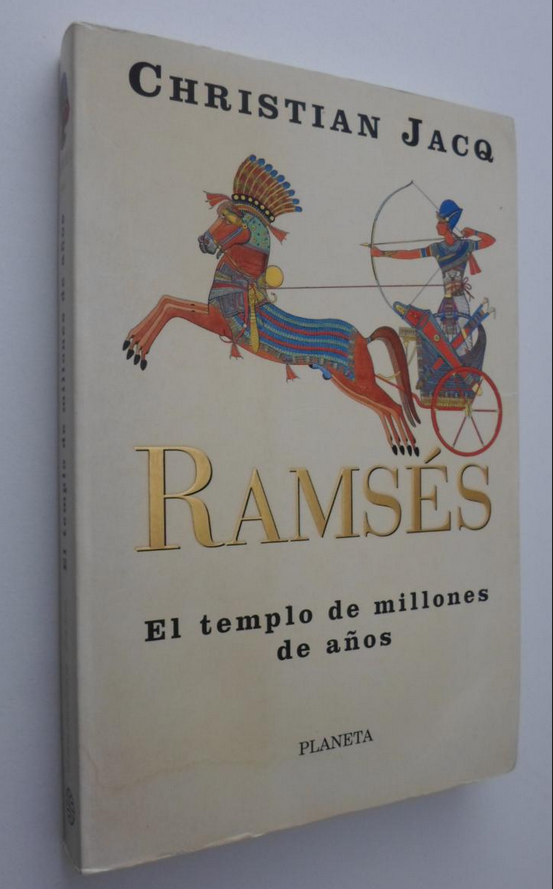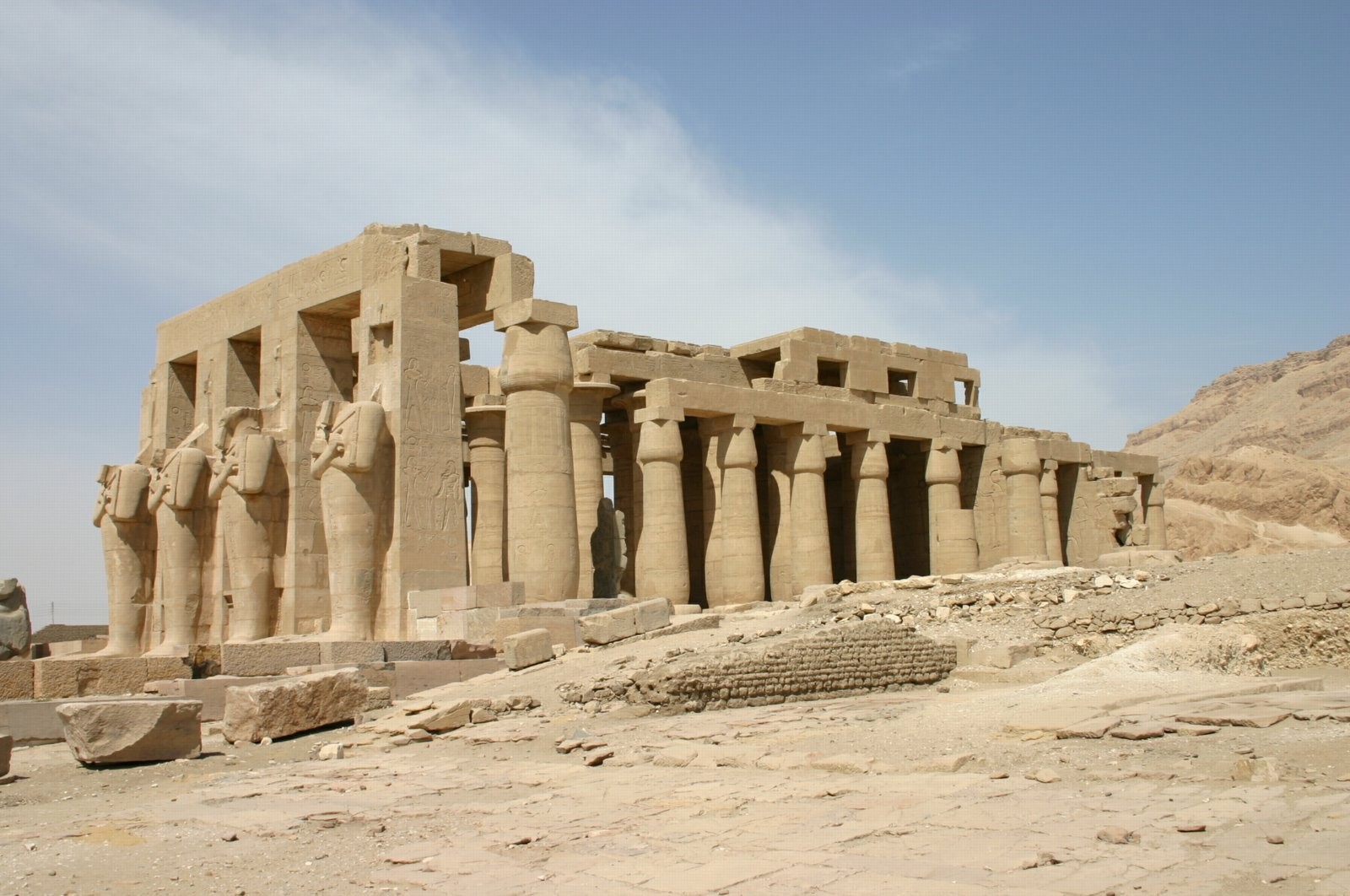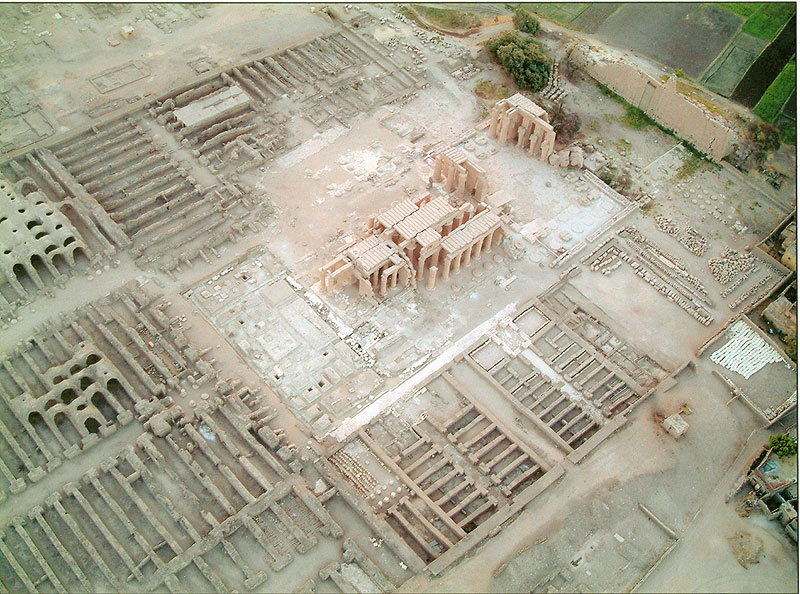[ENG/ESP] The Temple of Millions of Years narrates the vicissitudes of the first part of Ramses' reign. / El Templo de Millones de Años narra las vicisitudes de la primera parte del reino de Ramsés. [REVIEW/RESEÑA]

The complete saga of Ramses II is a beautiful collection of five books written by the French Christian Jacq that reveals to us an Ancient Egypt full of mysteries, with the universe of gods incarnated by Anubis (with the head of jackal the god of the mummifications), Matt (the goddess of justice and truth in which was believed incarnated the very essence of the pharaoh), Osiris (the god of the resurrection), Horus (the god of the sky) and all the constellation of the Egyptian gods that surround the figure and the pharaonic emblem of one of the most progressive ancient civilizations. ), Horus (the god of the sky) and all the constellation of Egyptian gods that surround the figure and the pharaonic emblem of one of the most progressive ancient civilizations, a millenary story told with absolutely true facts.
A week ago I told you about the first book in this article referring to the end of the childhood and the beginning of the adolescence of Ramses II known universally for his long reign and for his influence in the Ancient Age as Ramses.
| Le Fils de la Lumière narrates the youthful adventures of Ramses II before he became the most famous pharaoh of Egypt. |  |
|---|
La saga completa de Ramsés II es una hermosa colección de cinco libros escrita por el francés Christian Jacq que nos revela un Antiguo Egipto lleno de misterios, con el universo de dioses encarnado por Anubis (con la cabeza de chacal el dios de la momificaciones), Matt (la diosa de la justicia y la verdad en la cuál se creìa encarnada la esencia misma del faraón), Osiris (el dios de la resurrección.), Horus (el dios del cielo) y toda la constelación del dioses egipcios que rodean la figura y el emblema faraónico de una de las civilizaciones antiguas más progresistas, una historia milenaria novelada con datos absolutamente ciertos.
Hace una semana les hablé del primer libro en este artículo haciendo referencia al fin de la infancia y el comienzo de la adolescencia de Ramsés II conocido universalemente por su largo reinado y por su influencia en la Edad Antigua como Ramsés.
| El Hijo de la Luz narra las peripecias juveniles de Ramsés II antes de transformarse en el más famoso faraón de Egipto. |  |
|---|

Today I am going to refer to the second book that continues to show us an incredible Egypt where the reign of peace and harmony reigns above all things in an empire as vast as the Egyptian constantly threatened from the north by the Hittite army based in the Anatolian plateau (now Turkey) and the wild tribes of Nubia (now Sudan) trying to conquer the land of the pharaohs, prodigal of food (the Nile Delta) and minerals (the mines of the desert).
In The Temple of Millions of Years we see a Ramses absolutely committed to the construction of his personal temple - the famous Rameseo - not so much for personal vanity but as a cult of the gods to reinforce his ka and the pharaonic figure that rather than as a symbol of true and proper power is represented as a paternalistic figure whose only goal is the welfare of the people of Upper and Lower Egypt.
Let us remember that in Egypt there were no slaves. Yes, there was instead the figure of the servant, understood as a person who worked and had a salary (there was not yet cash) that was generally fixed through barter in goods (sandals and mats to rest undoubtedly the most appreciated goods in everyday use to survive, but also oil and other food goods).

Hoy me voy a referir al segundo libro que nos sigue mostrando un Egipto increíble donde priva por sobre todas las cosas el reinado de la paz y la armonía en un imperio tan vasto como el egipcio constantemente amenazado desde el norte por el ejército hitita que tiene su base de operaciones en el altiplano de Anatolia (actual Turquía) y las tribus salvajes de la Nubia (actual Sudán) que tratan de conquistar la tierra de los faraones, pródiga de alimentos (el Delta del Nilo) y de minerales (las minas del desierto).
En El Templo de Millones de Años vemos a un Ramsés absolutamente empeñado en la construcción de su templo personal -el famoso Rameseo- no tanto por vanidad personal sino como un culto a los dioses para reforzar su ka y la figura faraónica que más que como un símbolo de poder verdadero y propio es representanda como una figura paternalista cuyo único objetivo es el bienestar del pueblo del Alto y Bajo Egipto.
Recordemos que en Egipto no existían los esclavos. Si, existía en cambio la figura del siervo, entendiendo como tal una persona que trabajaba y tenía un salario (no existía todavía el dinero metálico) que se fijaba generalmente a través del trueque en bienes (sandalias y esteras para descansar sin lugar a dudas los bienes más apreciados en el uso cotidiano para sobrevivir, pero también aceite y otros bienes alimentarios).

Unexpectedly Sethi the father of Ramses who was preparing him for his ascension to the throne dies. And Ramses is the designated heir.
Already from the moment he had put him in front of the wild bull in the middle of the desert the pharaoh had implicitly accepted the idea that to succeed him was not his firstborn Chenar, a court intriguer, ambitious and unscrupulous who only aspired to rule for his personal satisfaction and his friends regardless of the respect that every pharaoh should have of the Rule of Maat, but Ramses the second son in order of succession.
After ruling a relatively short period of time (fifteen years) for what was the pharaonic dynasty Sethi dies and the young Ramses faces to make use of an immense power to which he is not yet prepared.
Besides he will have to face the intrigues of his brother Chenar, of his sister Dolente and her husband Sary, former instructor of Ramses himself, of the courtiers allied with him, the Hittite army that sees in the death of Sethi a favorable opportunity to invade Egypt moving through Canaan and the Syrian desert to seize the Nile Delta (Upper Egypt) the richest part of the country, the nomadic tribes that ravage the desert (Bedouins and Libyans) and the wild tribes of Nubia who do not accept being an Egyptian protectorate.
So much for a young man. Who, despite his age, knows that by allying himself with unconditional friends he will be able to face all these dangers.
And in Ameni (scribe and friend since school) he finds the ideal person to control the economic and legal aspect of the kingdom. Meticulous to the point of exasperation, he does not let any detail go unnoticed.
In Moses he finds the person who will supervise the construction of all the temples although in the Hebrew born in Egypt begins to take shape the figure of a new and unique God and that will motivate years later the exodus and the break of the friendship with the pharaoh.
In Asha another childhood friend, born into a noble family, he will find the ideal Foreign Minister to negotiate peace with his various enemies, especially the Hittites considered at that time the strongest army in the world, trying to reconcile the interests of the two brothers to avoid a tragedy. The goal of Ramses will always be to ensure peace, to avoid war and the bloodshed that this has always entailed. A lesson he has learned from his father.
Setau the snake charmer who does not love the worldly life and prefers to stay in the desert accompanied by his beautiful Nubian wife Loto is appointed official supplier of the Hospital of Menfi preparing an innumerable amount of remedies with the poison striated to the cobras and other snakes of the desert.
And behind all Serramanna, the Sardinian pirate who becomes head of his personal guard. And who finally - at the end of the saga - will give his life to defend the pharaoh.
The Ministry of Agriculture is entrusted to Nedjem, the palace gardener, faithful friend, advisor to the young monarch on agricultural matters.
And mother Tuya, the great royal wife of the pharaoh Sethi who becomes a continuous source of advice for Ramses.
And in the middle of this protective circle that surrounds the young pharaoh, the powers of darkness incarnated at the beginning by the Libyan magician Ophir whose goal is to convert Egypt to the religion of the god Aten and to proclaim Lita, descendant of the heretic pharaoh Akhenaton, the new queen. And for this he uses the good faith of Moses trying to lead him, with deception, to his cause.
Akhnaton had been defenestrated from the temple of the Egyptian divinities for having rejected the myriad of gods of Ancient Egypt to accept the existence of only one, incarnated in himself.
Nefertari becomes the royal wife of Ramses and assumes part of the burden that fell on the mother's shoulders, but the conspiracies do not cease.
An evil spell against the new queen pregnant with her firstborn (a girl who will be called Meritamon) manages to be stopped thanks to the magical barrier created by concoctions and amulets of Setau and his wife, the Nubian Loto.
At this point Tuya convinces his son that the only way to stop the forces of evil is the construction of a "millenary mansion" that can provide the pharaoh with the necessary energy - the ka - for his battle against the forces of evil.
And Ramses chooses Luxor for that purpose. And he orders to Bakhen, ex-chief of the guard of Sethi and instructor of first weapons of Ramses, now named priest of Thebes after having left the career of the weapons, the construction of the new temple: the Ramesseum. A religious complex that will not only be his mortuary temple but also a set of secondary temples dedicated to the worship of the remaining divinities.
The satisfaction of Ramses to fulfill his dream with the completion of the Ramesseum is marred by the sadness of seeing his childhood friend Moses flee Egypt accused of murder.
The Hebrew after a heated argument with Sary, the brother-in-law of Ramses, who has been removed from his position as preceptor as a conspirator and instigator of the complor to dethrone him and has been relegated as a supervisor in the construction of stone blocks in the construction of the pyramids, accidentally kills him and fearing to be accused he takes refuge in a nomadic tribe of the desert. Sary, obsessed by hatred, blackmailed the Hebrew workers by withholding part of their wages with the threat of accusations against them and subsequent deportation from Egypt.
The novel ends with the arrival of a coded message from Asha to Ramses: the Hittite with his supreme military chief Hattusili has decided to attack Egypt.

Improvisamente Sethi el padre de Ramsés que lo estaba prepararando para su subida al trono muere. Y Ramsés es el heredero designado.
Ya desde el momento en que lo había puesto de frente al toro salvaje en medio del desierto el faraón, implícitamente había aceptado la idea de que a sucederlo no fuera su primogénito Chenar, un intrigante de corte, ambicioso y sin escrúpulos que solo aspiraba a gobernar para su satisfacción personal y de sus amigos sin tener en cuenta el respeto que cada faraón debía de tener de la Regla de Maat, sino Ramsés el segundo hijo en orden de sucesión.
Después de gobernar un período de tiempo relativamente breve (quince años) para lo que era la dinastía faraónica Sethi muere y el joven Ramsés se enfrenta a hacer uso de un inmenso poder al cuál todavía no está preparado.
Aparte deberá hacer frente a las intrigas de su hermano Chenar, de su hermana Dolente y su esposo Sary antiguo instructor del mismo Ramsés, de los cortesanos aliados con él, al ejécito hitita que ve en la muerte de Sethi una ocasión propicia para invadir Egipto desplazándose a través de Canaan y el desierto sirio para apoderarse del Delta del Nilo (Alto Egipto) la parte más rica del país, a las tribus nómades que asolan el desierto (beduinos y líbicos) y a las tribus salvajes de la Nubia que no aceptan ser un protectorado egipcio.
Demasiado para un joven. Que no obstante su edad sabe que aliándose con amigos incondicionales logrará hacer frente a todos estos peligros.
Y en Ameni (escriba y amigo desde la escuela) encuentra la persona ideal para controlar el aspecto económico y legal del reino. Meticuloso hasta la exasperación no deja pasar ningún detalle por ello.
En Moisés encuentra la persona que supervisará la construcción de todos los templos aunque en el hebreo nacido en Egipto comienza a tomar forma la figura de un nuevo y único Dios y que motivará años más tarde el éxodo y la rotura de la amistad con el faraón.
En Asha otro amigo de la infancia, nacido en una noble familia, encontrará el Ministro de Relaciones Exteriores ideal para negociar la paz con sus diversos enemigos, especialmente los hititas considerado en ese momento el ejército más fuerte del mundo, tratando de conciliar los intereses de los dos hermanos para evitar una tragedia. El objetivo de Ramsés será siempre el de asegurar la paz, evitar la guerra y el baño de sangre que eso siempre ha comportado. Una lección que ha aprendido del padre.
Setau el encantador de serpientes que no ama la vida mundana y prefiere quedarse en el desierto acompañado por su bella esposa nubia Loto es designado proveedor oficial del Hospital de Menfi preparando una innumerable cantidad de remedios con el veneno estraído a los cobras y demás serpientes del desierto.
Y detrás de todos Serramanna, el pirata sardo quien se transforma en jefe de su guardia personal. Y que finalmente -al final de la saga- dará su vida por defender al faraón.
El Ministerio de Agricultura es confiado a Nedjem, el jardinero de palacio, amigo fiel, consejero del joven monarca en temas agrícolas.
Y la madre Tuya, la gran esposa real del faraón Sethi que se transforma en una fuente continua de consejos para Ramsés.
Y en medio de este círculo protectivo que rodea al joven faraón, las potencias de las tinieblas encarnadas al inicio por el mago libio Ofir cuyo objetivo es convertir a Egipto a la religión del dios Atón y a proclamar a Lita, descendiente del hereje faraón Akhenaton, la nueva reina. Y para ello se sirve de la buena fe de Moisés tratando de llevarlo, con engaños, hacia su causa.
Akhenaton había sido defenestrado del templo de las divinidades egipcias por haber rechazado la miríade de dioses del Antiguo Egipto para aceptar la existencia de una solo, encarnado en él mismo.
Nefertari se transforma en la esposa real de Ramsés y pasa a asumir una parte de la carga que recaía sobre las espaldas de la madre, pero las conspiraciones no cesan.
Un maleficio contra la nueva reina embarazada de su primogénito (una niña que se llamará Meritamon) logra ser detenido gracias a la barrera mágica creada por brebajes y amuletos de Setau y su esposa, la nubia Loto.
A este punto Tuya convence a su hijo que la única forma de detener las fuerzas del mal es la construcción de una "mansión milenaria" que pueda proporcionar al faraón la energía necesaria -el ka- para su batalla contra las fuerzas del mal.
Y Ramsés elige Luxor para tal fin. Y ordena a Bakhen ex-jefe de la guardia de Sethi e instructor de primeras armas de Ramsés, ahora nombrado sacerdote de Tebas despus de haber dejado la carrera de las armas, la construcción del nuevo templo: el Ramesseum. Un complejo religioso que no será solo su templo mortuorio sino también un conjunto de templos secundarios dedicados a la adoración de las restantes divinidades.
La satisfacción de Ramsés al cumplir su sueño con la finalización del Ramesseum está empañada por la tristeza de ver a su amigo de la infancia Moisés huir de Egipto acusado de homicidio.
El hebreo luego de una acalorada discusión con Sary, el cuñado de Ramsés, que destituido de su cargo de preceptor como conspirador e instigador del complor para destronarlo ha sido relegado como supervisor en la construcción de bloques de piedra en la construcción de las pirámides, lo mata accidentalmente y ante el temor de ser acusado se refugia en una tribu nómade del desierto. Sary obnubilado por el odio se dedicaba a chantajear a los trabajadores hebreos reteniéndoles una parte de su salario con la amenaza de denuncias contra ellos y posterior deportación de Egipto.
La novela termina con la llegada de un mensaje en código de Asha a Ramsés: el hitita con su jefe militar supremo Hattusili ha decidido atacar Egipto.


An adventure story on the one hand, but an academic novel on the other, it illustrates the peculiarities of an ancient kingdom that has not had the space it deserves in Western society.
The Egypt of the pharaohs was an era where science, literature and knowledge in general always prevailed over the warlike aspect that at that time was the pawn of empires in the rest of the world.
Except for the annexation as protectorate of Nubia (now Sudan) considered part of Lower Egypt, it was an empire that never had expansionist ambitions or conquest, basing its power on religious worship and respect for social order and justice.
The union with Upper Egypt (the so-called Nile Delta) base of the empire and seat of the main economic activities was always the goal of most of the pharaohs.
And Ramses during his more than sixty years of reign was able to achieve it.

Relato de aventuras por un lado pero novela académica por el otro nos ilustra particularidades de un antiguo reino que no ha tenido a nivel de divulgación en la sociedad occidental el espacio que se merece.
El Egipto de los faraones fue una era donde las ciencias, la literatura y el conocimiento en general siempre prevalecieron sobre el aspecto bélico que en ese momento empeñaba los imperios en el resto del mundo.
Salvo la anexión como protectorado de Nubia (actual Sudán) considerada parte del Bajo Egipto, fue un imperio que nunca tuvo ambiciones expansionísticas ni de conquista, basando su poder en el culto religioso y en el respecto del orden social y la justicia.
La unión con el Alto Egipto (el llamado Delta del Nilo) base del imperio y sede de las principales actividades económicas fue siempre el objetivo de la mayor parte de los faraones.
Y Ramsés durante sus más de sesenta años de reinado pudo concretizarlo.











Comments